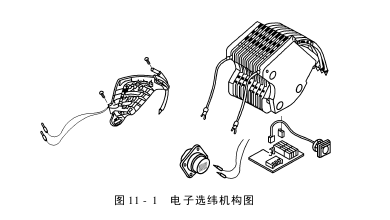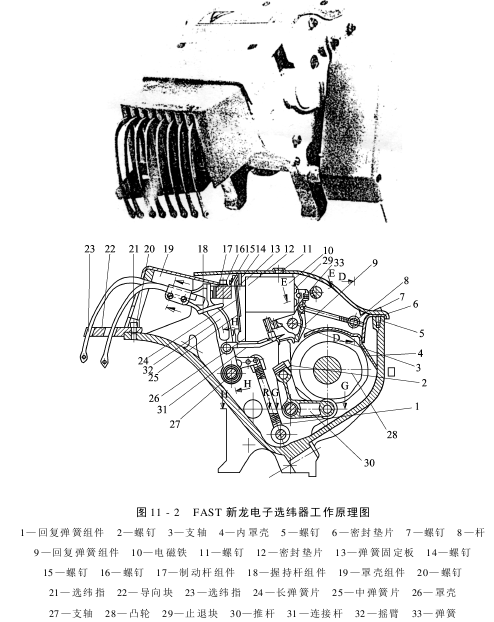With the advancement of science and technology, electronic technology has been widely used. The automation level of rapier looms has been further improved in recent years. The weft selection device has also developed from the original mechanical weft selection to today’s electronic weft selection device. Select weft.
1. Types of electronic weft selection devices
1. Stepper motor-driven weft selection finger form
This is the most advanced form in the world today, such as Picanol’s GAMMA rapier weaving The Suzhou Bigiale GTXPLUS loom has adopted this form. The Gaochun Textile Machinery GJ600 rapier loom and the “classic” rapier loom of Guangdong Fengkai Machinery Manufacturing Co., Ltd. have also begun to adopt this weft selection form. .
It is driven by an independent module. Each module is composed of an independent stepper motor and weft selection finger. It can be up to eight colors. Since it can be controlled by the loom microcomputer, it can be synchronized with the loom speed and weft cycle. , the weft yarn runs straight, can maintain constant low tension, and can set the best threading position. The modules are interchangeable. Since there is no mechanical movement, there is no need for lubrication and maintenance, and it can be more adapted to high speeds (Figure 11-1).
2. Linear motor driven weft finger selection form (combined by Shumate and Vanmate) TM11E super-excellent loom and Lenado loom produced by Italian PROMATECH company, The K88 loom and the G6300 loom produced by Sulzer both adopt self-developed linear motor-type weft selection devices. They have a compact structure, small size, easy operation by the operator, are suitable for high speeds, and work stably. Now Ningbo Voyage Textile Machinery Co., Ltd. has cooperated with Itema (Shanghai) Textile Machinery Co., Ltd.

3. Electromagnetic electronic weft selection device
At present, most looms at home and abroad use electromagnetic electronic weft selection devices, such as foreign SM93 type, C401 type, P401 type, FAST type, GTM type, THEMA11E type Rapier looms, domestic China Textile Machinery, Xihang Company, Titan Textile Machinery, Liaocheng Textile Machinery, Jingwei Textile Machinery, Hangzhou Textile Machinery, Longli Textile Machinery, etc. all use this type of weft selector device. This series of devices is suitable for medium to high speed range. At present, this device has been mass-produced in China, with relatively stable quality, low cost, and low machine material consumption.
Taking the FAST electronic weft selector as an example to illustrate the working principle of the electromagnetic weft selection device. The electronic weft selector is equipped with multiple weft selection fingers, which can select a variety of weft yarns. The electronic weft selector controls the weft selection sequence based on electronic signals.
The main components of the weft selector are shown in Figure 11-2. The rotation of the cam 28 is transmitted through the loom pulley.
When the power signal is sent to the electromagnet 10, the stop block 29 is sucked down under the electromagnetization of the electromagnet. When the cam rotates to a certain angle, the cam 28 pushes the push rod 30, causing the lower end slope of the connecting rod 31 to contact the end surface of the push rod, forming a fulcrum to swing backward around the fulcrum.
The rocker arm 32 is pushed to rotate through the connecting rod 31, so that the weft selection finger 19 moves downward, and the weft selection finger sends the weft yarn into the weft feeding rapier jaw. When the electromagnet 10 is not energized, the backstop block 29 is released by the action of the spring 33. At this time, the connecting rod 31 has no fulcrum and the weft selector does not feed the weft.
2. Technical performance of electronic weft selection device
The following mainly introduces the technical performance requirements of electromagnet type weft selection device:
(1) The electromagnetic electronic weft selection device rotates once when the main shaft of the loom rotates once , only one weft selection finger must work at a time, and it should work cyclically, continuously, and stably according to the set program. There cannot be two weft selection fingers working at the same time or intermittently.
(2) All connecting shafts of the electromagnetic electronic weft selection device should rotate flexibly and should not have a sense of blockage.
(3) The height and height difference of all weft selection fingers should comply with the set values of the host machine, and there should be no collision with the fixed guide rail to ensure that the weft yarn can be correctly introduced into the jaws of the weft feeding rapier head. For example: the height difference of SM93 electronic weft selection device is ≤6mm, the height difference of THEMA11E electronic weft selection device is 28~33mm, and the height difference of FAST electronic weft selection device is ≤6mm.
(4) The suitable voltage for the core iron coil (electromagnet) of the electromagnetic electronic weft selection device is DC 24~30V. The temperature rise of the coil after continuous operation is ≤25°C. The core iron suction force should be more than 2 times greater than the electromagnet spring pressure.
(5) Rated speed, vibration, idle noise level, and idle power consumption are all selected by the overall design indicators of the loom. Currently, the selected parameters and indicators of domestically produced mid-to-high-end looms are as follows:
FAST Type: vehicle speed 600r/min; empty vehicle noise pressure level ≤78dB; empty vehicle power consumption ≤65W. Vibration x≤1.5cm/s; y≤1cm/s; z≤1cm/s.
SM93 type: vehicle speed 400r/min; empty vehicle noise level ≤86dB; empty vehicle power consumption ≤65W. Vibration x≤3cm/s; y≤3cm/s; z≤3cm/s.
(6) Oil leakage or oil seepage shall not occur after the electronic weft selection device is in operation.
(7) There should be no bumps or damage on the surface of the electronic weft selection device, and the paint layer should be smooth without peeling off.
(8) The lubrication method of the electronic weft selection device is determined by the overall design structure of the loom. Generally, there are two types of oil bath type and joint type oil injection hole type of pressure oil cup. The specific oil grade should be selected. It is clearly stipulated that No. 20 engine oil and calcium-based grease are generally used.

AAAretytuoiuo3453345klj,hfg






